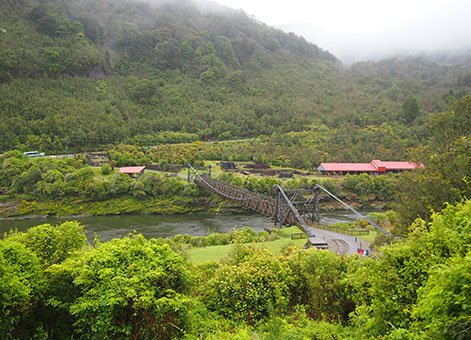Early explorer and surveyor, Thomas Brunner (1821?–1874), was the first to identify bituminous coal fields in the Grey Valley in the late 1840s. Mining in his namesake gorge did not start until the 1860s.

View of the coalmining town of Brunner, showing the bridge and mine. Ref; PA1-0-498-36, Alexander Turnbull Library, Wellington, New Zealand.
By the 1880s the underground Brunner Coal Mine was the largest producer in New Zealand and had associated works, such as a railway bridge, as well as an ever expanding settlement. There were also other industries at Brunner, including brickmaking and coke production.
A few years later, in 1896, the mine was the scene of New Zealand’s deadliest industrial incident, when 65 workers died as a result of gas igniting. Despite the event, production continued, reaching its height in 1901. At its peak the mine employed around 300 men and boys. A few years later the mine closed but small scale operations continued until the 1930s.

Brunner Mine historic site, November 2014. IPENZ.
The social impact of the Brunner Mine Disaster and other local mining tragedies is demonstrated through numerous memorials. The first memorial at Brunner was established in 1900, and on its centenary another memorial was unveiled, including the names of those who died in subsequent similar local tragedies at the Dobson (1926), Kaye and Party (1940), Strongman (1967) and Boatman’s No 4 (1985) mines.

Stamped brick at Brunner Mine historic site, Novemeber 2014. IPENZ.
In 2007 a memorial was erected in Rungaga specifically to honour the 19 workers who died in the Strongman Mine explosion. This was New Zealand’s largest underground mine at the time and, up until that point, was said to have an impeccable safety record.
In 2013 another memorial was erected in the Karoro cemetery in Greymouth. This commemorates all the dead from local mining disasters to date, including the 29 workers who perished in the Pike River Mine (2010). Coal mining continues to be economically dominant locally, with most of it being for export.
Heritage recognition
This place has been recognised by Heritage New Zealand as a:
Historic Area (List no.7051)
Brunner Coal Mining Remains Historic Area: New Zealand Heritage List/Rarangi Korero information
Category 1 historic place (List no.4996)
Brunner Industrial Site: New Zealand Heritage List/Rarangi Korero information
Category 2 historic place (List no.7399)
Suspension Bridge: New Zealand Heritage List/Rarangi Korero information
https://www.heritage.org.nz/the-list/details/7399
Find out more
Access
There is a carpark on State Highway 7 and visitors can cross the suspension bridge to access the main mine site on the Taylorville Road side of the river.
References
“Brunner Mine Site Walk” Department of Conservation, accessed 7 September 2015.
Simon Nathan, “West Coast places - Grey coal towns” Te Ara - Encyclopedia of New Zealand. Last modified 17 June 2015.
Location
State Highway 7, between Dobson and Stillwater, Westland, South Island.
